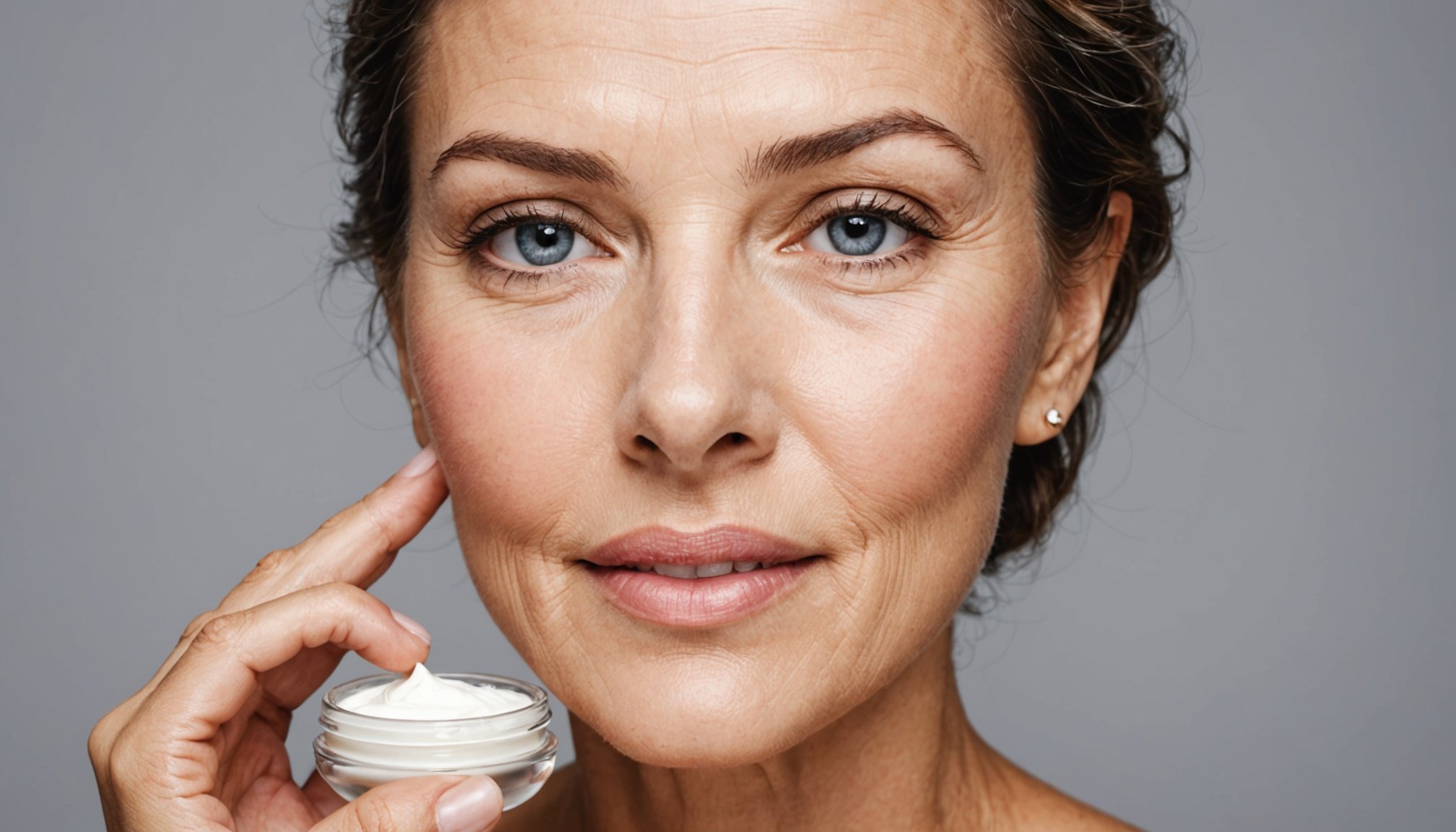Key Ingredients for Moisturizers
When it comes to moisturizer ingredients, understanding the fundamentals such as humectants, emollients, and occlusives can significantly impact your anti-aging and hydration regimen.
Humectants
Humectants like hyaluronic acid and glycerin are pivotal for drawing moisture into the skin. These ingredients act like a sponge, pulling water from deeper layers or the environment into the outer layer of the skin, helping to enhance skin hydration. Hyaluronic acid can hold up to 1,000 times its weight in water, making it an exceptional ingredient for boosting skin moisture.
In the same genre : Definitive Guide to Jewelry Maintenance: Prevent Tarnish in Humid UK Weather
Emollients
Fatty acids and ceramides fall into the emollient category. They fill in the gaps between skin cells, creating a smooth surface and bolstering the skin barrier. Emollients are essential for mature skin as they improve texture and offer a protective layer against environmental damage.
Occlusives
Occlusives, including natural oils like jojoba and sunflower seed oil, form a physical barrier on the skin to lock in moisture, preventing moisture loss. They complement the work of humectants and emollients, making them indispensable in a comprehensive skincare routine targeting hydration.
This might interest you : Ultimate Guide: Top Tips for Choosing Ideal Heels to Master Cobblestone Streets in UK Cities
Understanding Mature Combination Skin
Mature combination skin presents a distinct challenge as it combines both oily and dry areas, often accompanied by signs of aging such as reduced moisture retention and changes in skin texture. As skin ages, its ability to maintain hydration diminishes, making it crucial to address diverse hydration needs effectively.
For this skin type, balancing moisture without exacerbating oiliness is key. Skin types like these require products that target both dryness and excess oil, ensuring that neither condition is neglected. Hydration must be tailored to cater to oil-prone areas, like the T-zone, while delivering ample moisture to drier patches.
The changes in oil production and skin elasticity further intensify the need for a balanced skincare regimen. Aging skin tends to be less resilient, often feeling rougher, and requiring more targeted care to maintain smoothness and suppleness. Hence, understanding the complexities of mature combination skin can significantly enhance the effectiveness of your skincare routine, helping you to achieve a harmonious balance that supports overall skin health.
Understanding Mature Combination Skin
Mature combination skin combines both oily and dry areas, presenting unique challenges in maintaining hydration and balance. As skin ages, its moisture retention ability diminishes, necessitating targeted care to cater to varying hydration needs. Addressing these needs effectively is crucial for achieving healthy, balanced skin.
This skin type is often marked by an oily T-zone (forehead, nose, chin) and drier areas on the cheeks and around the eyes. Such diversity in skin types complicates the selection of skincare products, as each area demands different treatment.
Aging contributes to a decrease in skin elasticity and a rougher texture, further complicating skincare routines. This is why it’s important to focus on strengthening the skin barrier and incorporating both hydrating and oil-absorbing products. These solutions allow for customised treatment, preventing excessive drying or oiliness in targeted areas.
For mature combination skin, consider using products with ingredients designed for specific hydration needs, ensuring hydration and smoothness while preserving elasticity. Tailoring your routine to these complex requirements supports a balanced moisture level, helping to maintain a youthful and radiant appearance.
Understanding Mature Combination Skin
Mature combination skin uniquely intertwines oily and dry areas, each requiring tailored attention. This skin type is complex, featuring an oily T-zone while drier patches often appear on the cheeks. As skin ages, it undergoes significant changes, notably a decline in its moisture retention capabilities. This decline necessitates careful consideration of hydration needs, as maintaining balanced moisture becomes a pressing challenge.
Ageing influences skin texture, leading to increased roughness and diminished elasticity, complicating skincare efforts. To effectively care for this skin type, strategies must emphasise addressing these hydration needs while fortifying the skin barrier. Skincare regimens for mature combination skin benefit from products that simultaneously hydrate dry areas and balance oil production in greasier zones. This ensures that neither dryness nor oiliness dominates, promoting a smoother, more youthful skin appearance.
Crafting your skincare routine to meet the special requirements of mature combination skin enhances your skin’s overall resilience and health. Selecting products that cater to its unique hydration needs supports a harmonious skincare approach, offering both essential moisture and the protective support aging skin craves.
Choosing the Right Texture
Selecting the appropriate moisturizer texture for mature combination skin is essential for balancing hydration and skin comfort. The choice between creams, lotions, and gels can significantly impact how well your skin absorbs moisture and maintains a healthy appearance.
Creams are typically richer and provide a thicker barrier, making them ideal for drier areas often found in mature skin. They deliver deep hydration, particularly beneficial for overnight use. Conversely, lotions offer a lighter texture, suitable for those who prefer a quick-absorbing option during the day. They tend to work well in moderate climates where skin requires balanced moisture without feeling heavy.
Gels, known for their lightweight and refreshing feel, can be especially advantageous for oily-prone zones like the T-zone. They provide a mattifying effect while still ensuring sufficient hydration, preventing additional oiliness. Choosing between these textures requires considering personal preference, skin type, and environmental factors.
Matching the moisturizer texture to climate is also crucial. During humid months, lightweight formulas prevent excessive greasiness, while colder months may necessitate richer options for added protection. Understanding these aspects helps maintain a well-hydrated, balanced complexion tailored to individual needs.
Understanding Mature Combination Skin
Mature combination skin is a unique skin type combining oily and dry areas, often characterized by an oily T-zone (forehead, nose, chin) and drier cheeks. This dual nature can make it challenging to find a skincare routine that properly addresses distinct hydration needs. The primary struggle is ensuring that oilier regions do not become overly greasy while maintaining adequate moisture in dry areas.
As the skin ages, its ability to retain moisture wanes, resulting in significant changes in skin texture. Reduced elasticity and increased roughness require carefully selected products to maintain balance and smoothness. Ensuring proper hydration is critical, as it aids in preventing further textural degradation.
An effective skincare regimen for mature combination skin emphasises fortifying the skin barrier and tailoring products to meet diverse hydration requirements. By recognising and addressing the hydration needs of different areas, individuals can achieve a harmonious complexion. This approach not only addresses dryness and oiliness but also helps maintain a youthful, radiant appearance through a well-rounded skincare routine designed for mature combination skin.
Understanding Mature Combination Skin
Mature combination skin is a complex skin type that brings unique characteristics and challenges. This type integrates both oily and dry areas, typically with an oily T-zone and drier cheeks. The balance of hydration needs between these variations is essential yet challenging.
As we age, the skin’s ability to retain moisture deteriorates, decreasing elasticity and making it require more attention. Maintaining balance becomes vital to ensure that neither dryness nor oiliness exacerbates. The goal is to fortify the skin barrier while delivering hydration where needed.
Hydration plays a key role in safeguarding against age-related textural changes, such as increased roughness. Placing emphasis on mature combination skin care involves using tailored products meeting each area’s specific hydration needs. Providing moisture, while controlling oil, contributes to a smoother overall texture and appearance.
Achieving effective results demands a comprehensive understanding of this skin type and its demands. Properly addressing these complexities not only enhances the skin’s appearance but also supports its health and functionality as it ages. Selecting the right products to cater to diverse hydrate needs encourages a radiant and youthful skin complexion.








